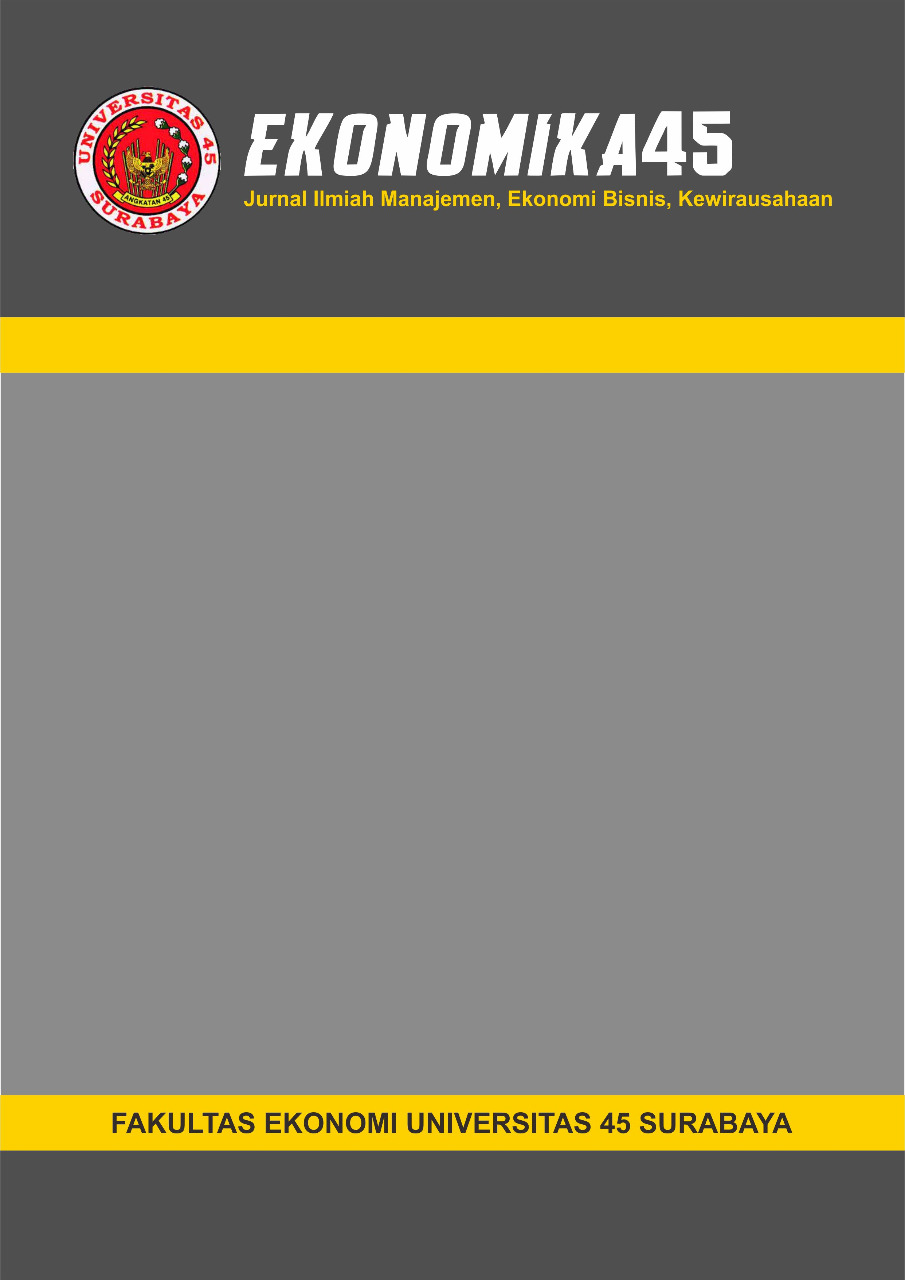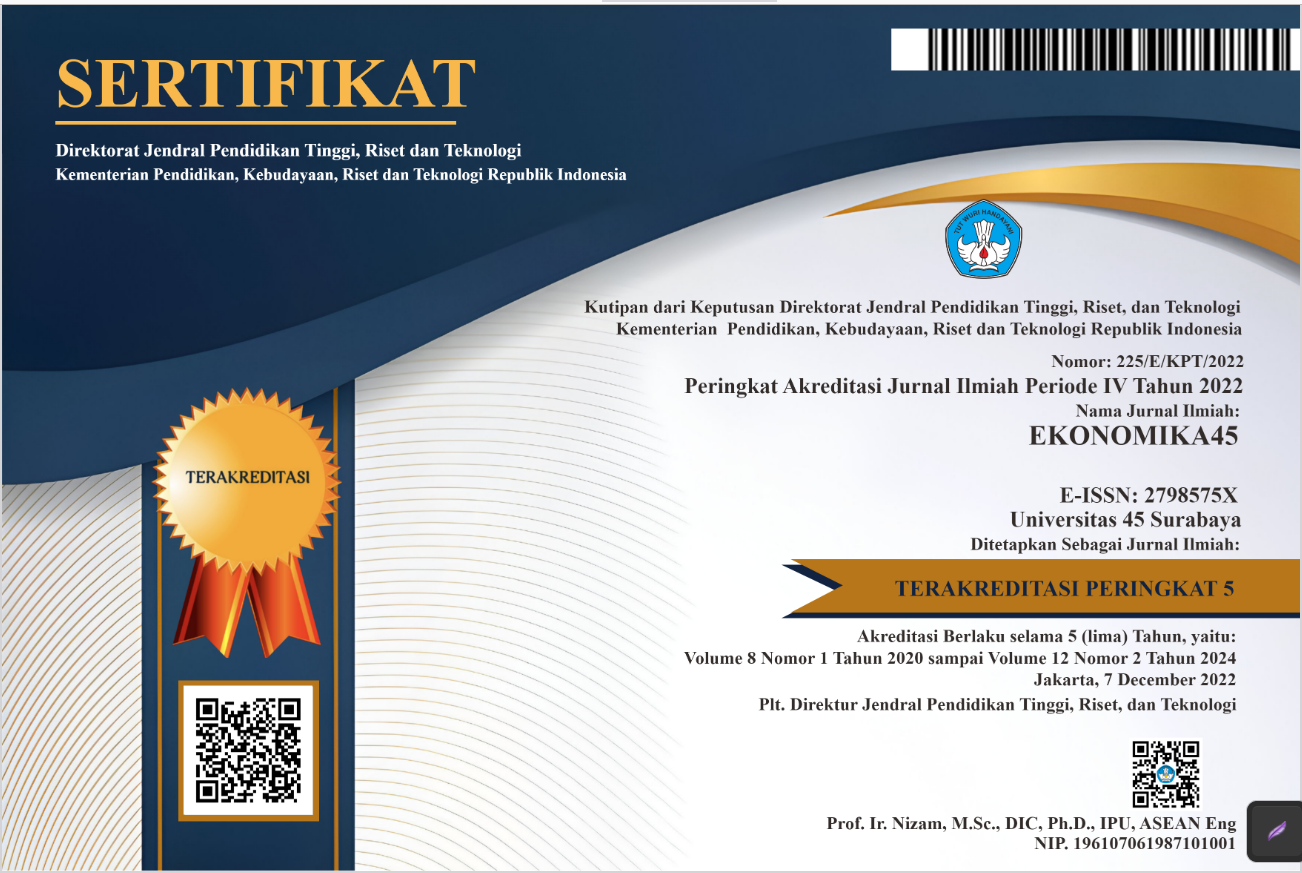Pengaruh Indeks Pembangunan Manusia, Pertumbuhan Ekonomi, Rumah Layak Huni, Fasilitas Kesehatan Dan Pernikahan Dini Terhadap Prevalensi Stunting di Indonesia
DOI:
https://doi.org/10.30640/ekonomika45.v12i2.4684Keywords:
Stunting, HDI, Economic Growth, Early MarriageAbstract
Efforts to address stunting have been carried out by the Indonesian government from the central to the regional levels, but the results have not met the targets set by the SDGs and national targets. This study aims to analyze the factors that cause stunting and to determine which factors are the most dominant in influencing stunting in Indonesia. This study uses a quantitative approach by applying the panel data multiple linear regression method. The data used in this study are secondary data sourced from BPS in the form of stunting prevalence data, Human Development Index, economic growth, livable housing, health facilities and early marriage from 2015 - 2023 in 34 provinces in Indonesia. The results of this study indicate that the HDI variable has a significant negative effect on the prevalence of stunting. The economic growth variable does not affect the prevalence of stunting. The livable housing variable does not affect the prevalence of stunting. The health facility variable has a significant negative effect on the prevalence of stunting. The early marriage variable has a significant positive effect on the prevalence of stunting. The findings of this study imply that 1) the government needs to take action to improve the quality of human resources through the dimensions of health, education and decent living standards 2) that economic growth does not affect the decline in stunting because there are other factors that have a greater influence on the prevalence of stunting 3) The government in collaboration with the community and institutions evaluates and controls budget provision activities for decent housing so that they are appropriate and on target 4) The government in collaboration with the community and institutions really needs to increase the availability of health facilities and health workers starting from integrated health posts, health centers to hospitals 5) the government really needs to increase socialization to the community through schools to provide education to adolescents about the many risks that arise in early marriage that can cause stunting in toddlers.
References
Alam, & Wahyu. (2024, January). Menko PMK singgung target capaian raih Indonesia Emas 2045 dalam konferensi internasional. Kementerian Koordinator Bidang Pembangunan Manusia dan Kebudayaan.
Ali Nasrun, M., & Rahmania. (2018). Hubungan indikator keberhasilan pembangunan ekonomi dengan stunting di Indonesia.
Alza, N., Yulianingsih, E., Abdul, N., Lapa, C., Martiona, N., & Ishak, S. (2023). Literature review: Dampak pernikahan usia dini terhadap stunting. Journal of Noncommunicable Diseases, 3(2), 120. https://doi.org/10.52365/jond.v3i2.930
Anam, F. S., & Saputra, S. A. (2021). The effect of human development index (IPM), Gini ratio, and gross domestic products on the number of stunting in Indonesia. International Journal of Innovative Science and Research Technology, 6(2). http://www.ijisrt.com926
Aurelya, T., Nurhayati, N., & Purba, S. F. (2022). Pengaruh kondisi sektor kesehatan terhadap pertumbuhan ekonomi di Indonesia. Jurnal STEI Ekonomi, 31(2), 83–92. https://doi.org/10.36406/jemi.v31i02.752
Badan Pusat Statistik. (2016). Indeks pembangunan manusia 2015.
Badan Pusat Statistik. (2021a). Hasil sensus penduduk 2020.
Badan Pusat Statistik. (2021b). Indeks pembangunan manusia 2020.
Badan Pusat Statistik. (2024). Pertumbuhan ekonomi Indonesia triwulan IV 2023, 3–16.
Biro Hukum Kementerian Kesehatan RI. (2022). Keputusan Menteri Kesehatan Republik Indonesia Nomor HK.01.07/Menkes/1928/2022.
Biro Hukum Kementerian PUPR RI. (2023). Peraturan Menteri Pekerjaan Umum dan Perumahan Rakyat Republik Indonesia Nomor 13 Tahun 2023 tentang Standar Teknis Standar Pelayanan Minimal Bidang Pekerjaan Umum dan Bidang Perumahan Rakyat.
Clarke, P., & Erreygers, G. (2018). Introduction to the special issue: Contributions to the history of health economics. OEconomia, 8(3), 275–277. https://doi.org/10.4000/oeconomia.4068
Damayanti, D. A., & Sentosa, U. (2020). Analisis kausalitas stunting, pertumbuhan ekonomi dan kemiskinan di Indonesia. EPB: Ekonomi Pembangunan dan Bisnis, 2(2). http://ejournal.unp.ac.id/students/index.php/epb/index
Dian, Y. (2020). Polemik stunting dan pembangunan. Fakultas Ekonomi dan Bisnis, Universitas Brawijaya.
Duana, M., Maisyaroh, S., Siregar, F., Anwar, S., Musnadi, J., Husna, A., Nursia, L. E., Umar, U. T., & Program Studi Kesehatan Masyarakat. (2022). Dampak pernikahan dini pada generasi Z dalam pencegahan stunting. COMSEP: Jurnal Pengabdian Kepada Masyarakat, 3(2).
Fajrianti, D., Yunitasari, E., & Pradanie, R. (2020). The correlation between personal reference: Health workers and health facilities with parenting in stunting prevention. Pediomaternal Nursing Journal, 6(2), 125. https://doi.org/10.20473/pmnj.v6i2.20966
Hari, D., Anshari, F., Clarissa, A., & Badan Pusat Statistik. (2024). Indeks pembangunan manusia 2023, xxii–169.
Hugo, M., & Hapsari, K. (2023). Hubungan pendidikan, pengetahuan, pendapatan keluarga negatif stunting.
Ida, R., Koesbardiati, T., Kinasih, S. E., Wahyudi, I., Ramadhiansyah, D., & Sa’diyah, K. (2024). Gender-informed curriculum development addressing child marriage and stunting prevention in multicultural communities, Singkawang City, West Kalimantan. Journal of Governance and Administrative Reform, 5(2), 229–246. https://doi.org/10.20473/jgar.v5i2.64473
Jaya, Kristiani, & Chadidjah. (2022). Modeling prevalence of stunting in relation to human development index in Indonesia. Journal of Mathematical and Computational Science. https://doi.org/10.28919/jmcs/7316
Downloads
Published
How to Cite
Issue
Section
License
Copyright (c) 2025 EKONOMIKA45 : Jurnal Ilmiah Manajemen, Ekonomi Bisnis, Kewirausahaan

This work is licensed under a Creative Commons Attribution-ShareAlike 4.0 International License.









